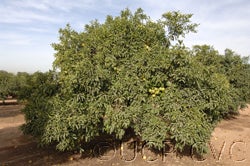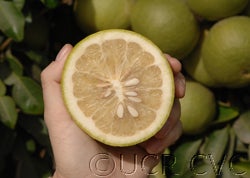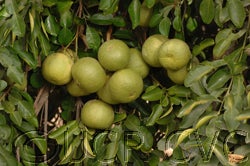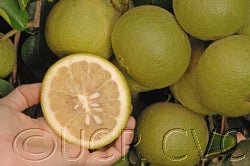Citrus latipes
CRC 3052
PI 230987
Source
Received as seed from Ed Pollock, Molong Road, Parkes, New South Wales, Australia, 1954. Collected by Forest Botanish of Forest Research Institure & College, Dehea Dun, U.P. India.
Parentage/origins
Parents unknown. Khasi Hills, Assam, India
Rootstocks of accession
C-35 citrange, Yuma Ponderosa lemon
Season of ripeness at Riverside
Unknown at this time
Notes and observations
1/14/1988, EMN: This accession was heat treated about 1975 for moving out of the tristeza quarantine area to Lindcove. Fruit matches the TCI description OK except that several fruits cut had 12 segments instead of 9.
11/29/2007, DK & TS: Large fruit, flattish, looks like a pummelo. Bears in a grapefruit-like cluster. Double leaves, winged petiole. Large, lush tree. Fruits greenish yellow when visited, starting to turn. Moderately thick, grapefruit-like skin. Fairly juicy, not bad taste at first, then unpleasant aftertaste.
Description from The Citrus Industry Vol. 1 (1967)
"Type.—Northeastern British India, Khasi Hills, Living Bridge (Hooker f. and Thomson). Herb. Kew.
Distribution.—Northeastern India: Khasi Hills; northern Burma; grows in the mountains at considerable elevation, 500-1,830 m [1,640-6,000 ft.].
Common name.—Khasi papeda.
A thorny tree similar to C. ichangensis but having leaf blades more variable in size and shape and with the tips subacute or even bluntly rounded, not apiculate or subcaudate with blunt points as in C. ichangensis. The flowers, instead of being borne singly in the axils of the leaves as in C. ichangensis, are sometimes, at least, borne in small axillary racemes with 5-7 flowers. These latter flowers are much smaller, are 4-merous (instead of 5-merous as is the large single flower of C. ichangensis), and all the parts are smaller. However, the fruits are borne singly and resemble those of C. ichangensis except for having a thicker peel, of which the inner layer is chalky white just below the outer green layer. The seeds are also smaller and more numerous than those of C. ichangensis and are arranged 5-7 in each segment.
The following is a detailed description of flowers and fruits (after Tanaka, 1928a, p. 155): Inflorescences racemose, having 5-7 flowers; peduncles short, 5-8 mm, pubescent; pedicels 7-8 mm long, moderately thick, becoming thicker at the upper end where they join the calyx, striated, glabrous; flower buds medium-sized, ovoid, about 7 X 9 mm, rounded at the apex, showing oil glands indistinctly at the surface; calyx discoid, 4 mm diam., lobes 4, broad, semicircular, wrinkled, slightly convex at the tip and curving outward, rather thick, slightly pubescent at margins, glabrous above; flowers, when open, 1.5 cm diam.; petals 4, spreading horizontally, thick, oval; stamens 18-20, 7-8 mm long and about 1 mm wide, filaments almost free at the tip but arranged in 6-7 groups each composed of 3-4 united together at the bases, thick, flat, wrinkled, pointed at the tip; anthers oval or elliptic-oval, about 1.5 mm long, pointed, with small gland at the apex; pistils shorter than stamens, about 7 mm long; ovaries depressed-globular, 2 mm diam.; styles rather stout, 2.5 mm long, 1 mm diam., distinctly articulated with the ovary; stigmas large, depressed-globose, 1.5-2.5 mm diam., with 4 sometimes indistinct furrows; fruits medium-sized, almost globular, slightly compressed at both ends; oil cells moderately small, more or less equal in size, rather dense, convex; peel somewhat thick, composed of rather dense tissue; central column (axis) of even width, moderately large; segments 9, fairly large, outer margin very much rounded, inner margin also rounded; pulp-vesicles few, fairly large, spindle-shaped, not short, relatively well developed with a thick membrane, stalks very short; seeds numerous, arranged 5-7 in each row, rounded, moderately large, parallel and horizontal.
This species was founded on plants collected in the Khasi Hills of northeastern India, but very similar forms are found in the mountains of northern Burma. The type specimen in the Kew Herbarium on which Swingle based C. latipes (1913c, p. 12) has a fruit in cross section measuring 5 cm in diameter, peel 5 to 6 mm thick, with nine segments.
In view of the extreme cold-resistance of the typical C. ichangensis (and its hybrid, the so-called Ichang lemon) it would be well worth while to introduce C. latipes into the United States and see if it also is hardy and perhaps of value for use in breeding new hardy acid citrus fruits and hardy rootstocks."
Availability
Not commercially available in California.
USDA Germplasm Resources Information Network page for Khasi papeda



